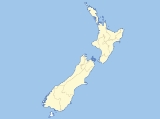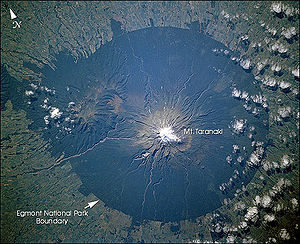
Egmont National Park
Encyclopedia

New Plymouth
New Plymouth is the major city of the Taranaki Region on the west coast of the North Island of New Zealand. It is named after Plymouth, Devon, England, from where the first English settlers migrated....
, close to the west coast of the North Island
North Island
The North Island is one of the two main islands of New Zealand, separated from the much less populous South Island by Cook Strait. The island is in area, making it the world's 14th-largest island...
of New Zealand
New Zealand
New Zealand is an island country in the south-western Pacific Ocean comprising two main landmasses and numerous smaller islands. The country is situated some east of Australia across the Tasman Sea, and roughly south of the Pacific island nations of New Caledonia, Fiji, and Tonga...
. It is named after the mountain which dominates its environs, which itself was named by Captain Cook after John Perceval, 2nd Earl of Egmont
John Perceval, 2nd Earl of Egmont
John Perceval, 2nd Earl of Egmont PC, FRS was a British politician, political pamphleteer, and genealogist...
, the First Lord of the Admiralty who promoted Cook's first voyage. Taranaki has been the Māori
Maori language
Māori or te reo Māori , commonly te reo , is the language of the indigenous population of New Zealand, the Māori. It has the status of an official language in New Zealand...
name for the mountain for many centuries, and the mountain itself now has two alternative official names, "Mount Taranaki" and "Mount Egmont".
The park, established in 1900, is dominated by the dormant volcano
Volcano
2. Bedrock3. Conduit 4. Base5. Sill6. Dike7. Layers of ash emitted by the volcano8. Flank| 9. Layers of lava emitted by the volcano10. Throat11. Parasitic cone12. Lava flow13. Vent14. Crater15...
of Mount Taranaki
Mount Taranaki
Mount Taranaki, or Mount Egmont, is an active but quiescent stratovolcano in the Taranaki region on the west coast of New Zealand's North Island. Although the mountain is more commonly referred to as Taranaki, it has two official names under the alternative names policy of the New Zealand...
. The park receives massive annual precipitation
Precipitation (meteorology)
In meteorology, precipitation In meteorology, precipitation In meteorology, precipitation (also known as one of the classes of hydrometeors, which are atmospheric water phenomena is any product of the condensation of atmospheric water vapor that falls under gravity. The main forms of precipitation...
which is essentially orographic in origin as moist westerlies moving inland from the Tasman hit Mount Taranaki and the adjacent Pouakai and Kaitake ranges and are thus forced to rise. Since the area has high annual rainfall and mild coastal climate there is a lush rainforest
Rainforest
Rainforests are forests characterized by high rainfall, with definitions based on a minimum normal annual rainfall of 1750-2000 mm...
covering the foothills- this forest is nationally significant for the total absence of beech trees (genus Nothofagus
Nothofagus
Nothofagus, also known as the southern beeches, is a genus of 35 species of trees and shrubs native to the temperate oceanic to tropical Southern Hemisphere in southern South America and Australasia...
).
Ecology
A rich Northern rātāMetrosideros robusta
Northern rātā , is a huge forest tree endemic to New Zealand. It grows up to 25 m or taller, and usually begins its life as a hemiepiphyte high in the branches of a mature forest tree; over centuries the young tree sends descending and girdling roots down and around the trunk of its host,...
/Rimu
Rimu
Rimu can mean the following:*Dacrydium cupressinum, also rimu, a tree endemic to New Zealand*Rimu, Southland, a locality in Southland, New Zealand*Rimu, West Coast, a locality in the West Coast region of New Zealand...
/Broadleaf forest is present, although the entire park ecosystem
Ecosystem
An ecosystem is a biological environment consisting of all the organisms living in a particular area, as well as all the nonliving , physical components of the environment with which the organisms interact, such as air, soil, water and sunlight....
displays distinct patterns of vegetative zonation - the former two large species of tree are common at lower elevations whereas Kamahi tends to dominate the stunted high altitude forest. In these old growth forests the Crown Fern, Blechnum discolor
Blechnum discolor
Blechnum discolor is a species of fern in the family Blechnaceae. This species is endemic to New Zealand. As noted by C. Michael Hogan, this species is found in a number of forest communities in diverse locations within New Zealand, and is sometimes a dominant understory component.Spores are...
, is a dominant understory plant species. The character of the plant communities continues to change with increasing altitude, to subalpine
Subalpine
The subalpine zone is the biotic zone immediately below tree line around the world. Species that occur in this zone depend on the location of the zone on the Earth, for example, Snow Gum in Australia, or Subalpine Larch, Mountain Hemlock and Subalpine Fir in western North America.Trees in the...
and alpine shrubland
Shrubland
Shrubland, scrubland, scrub or brush is a plant community characterized by vegetation dominated by shrubs, often also including grasses, herbs, and geophytes. Shrubland may either occur naturally or be the result of human activity...
s at high elevations, which are in stark contrast to the surrounding pasture farmlands. Notable among the geographical features of the park is its clear radial drainage pattern
Drainage system (Geomorphology)
In geomorphology, a drainage system is the pattern formed by the streams, rivers, and lakes in a particular drainage basin. They are governed by the topography of the land, whether a particular region is dominated by hard or soft rocks, and the gradient of the land. Geomorphologists and...
, which can be discerned in the satellite picture at right.
The Ahukawakawa swamp is a rare high-altitude (920m) sphagnum moss wetland located between Mt Taranaki and the Pouakai range. It contains many endemic species adapted to acid soils and low temperatures.

